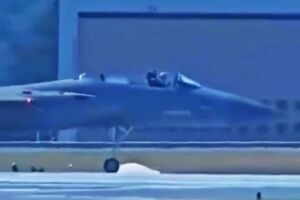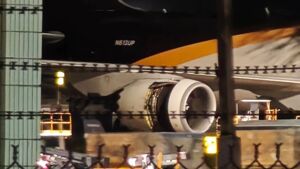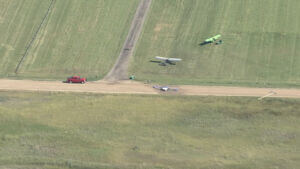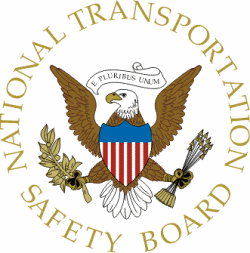Here are your stories for today...
Be safe out there!
Tom
Passenger accidentally ejects from F-15D Eagle in the US
Ricardo Meier
Incident occurred during taxi at Massachusetts Air National Guard base
National Guard base
A passenger in a US Air National Guard F-15D Eagle from the 104th Fighter Wing appears to have unintentionally ejected while the aircraft was taxiing at Barnes Air National Guard Base in Westfield, Massachusetts.
Video posted on social media shows the twin-seat fighter moving along the ramp when a puff of smoke emerges from the rear cockpit, followed by the canopy being blown off and landing on the left wing. The backseat occupant is seen near a deployed parachute close to the runway as the F-15 continues to roll past.
According to an unverified post on Facebook page, the individual was a member of the 104th Fighter Wing on an “incentive flight” — a ride offered to non-pilot personnel as a reward or morale booster.
The Air National Guard has not confirmed the passenger’s identity or condition. Ejections at zero altitude and near-zero speed, known as “zero-zero,” carry additional risks, though accidental ejections in such circumstances are extremely rare.
Based at Barnes since 1946, the 104th Fighter Wing operates F-15C/D Eagles on 24/7 air defense alert missions over the northeastern United States and is scheduled to transition to the F-35A Lightning II by 2026.
https://www.airdatanews.com/passenger-accidentally-ejects-from-f-15d-eagle-in-the-us/
A UPS cargo plane's engine scraped the ground and sparks flew after landing at Taoyuan International Airport.
Mirror News
A UPS cargo plane sparked while landing at Taoyuan Airport in the evening. The north runway is currently closed for inspection, and the airport company has simultaneously activated the emergency response mechanism.
Taoyuan Airport in the evening. The north runway is currently closed for inspection, and the airport company has simultaneously activated the emergency response mechanism.
Netizens shared live footage on the Facebook group "Kaohsiung Airport Aircraft Information Exchange" showing that after the UPS cargo plane landed on the north runway at around 8:08 tonight, the right wing engine of the aircraft seemed to touch the ground and sparks were emitted, sparking discussion among netizens.
The airport company explained that at 8:12 pm today (13th), the tower received a notification that UPS cargo flight 5X61 (B747-8F) had an engine touchdown incident while landing on the north runway. The airport company immediately dispatched personnel to inspect the runway and reported the incident to the Transportation Safety Committee, the Ministry of Transportation and Communications, and the Civil Aviation Administration of China in accordance with the "Rules for the Investigation and Handling of Aircraft Accidents and Major Accidents." The company also closed the north runway and notified the tower to suspend takeoffs and landings, maintaining single-runway operations. After landing, the cargo plane was parked at the 515 cargo apron pending the investigation by the Transportation Safety Committee. The airport company has also activated its response mechanism.
https://tw.news.yahoo.com/%E6%A1%83%E6%A9%9F%E9%A9%9A%E9%9A%AA%E4%BA%8B%E4%BB%B6-ups%E8%B2%A8%E6%A9%9F%E9%99%8D%E8%90%BD-%E7%99%BC%E5%8B%95%E6%A9%9F%E6%93%A6%E5%9C%B0-%E5%86%92%E7%81%AB%E8%8A%B1-143833293.html
Boulder man killed in glider crash southwest of Berthoud
By: Katie Parkins
LARIMER COUNTY, Colo. — A Boulder man was killed after his glider crashed southwest of Berthoud Wednesday morning.
killed after his glider crashed southwest of Berthoud Wednesday morning.
Law enforcement learned of an aircraft crash in the 3600 block of West County Road 2, located near the Larimer-Boulder county line, around 8:40 a.m. The Larimer County Sheriff's Office (LCSO), Berthoud Fire Protection District, and Thompson Valley EMS responded to the scene and found an ultralight glider that had crashed and caught fire.
After the flames were put out, first responders found the sole occupant — a Boulder man — dead inside the glider. The Larimer County Coroner's Office will release the man's name and cause and manner of death at a later time.
The sheriff's office reported that several nearby power lines and poles were severely damaged. Investigators believe the glider likely hit the electrical lines before coming to rest on the dirt road.
Crews from Poudre Valley REA (Rural Electrification Administration) are working on fixing the damage to the lines.
The cause of the crash is under investigation. No other injuries or property damage have been reported.
The Federal Aviation Administration (FAA) was notified of the crash. The sheriff's office said the investigation will remain with them due to the type of glider.
“Losing someone you care about is never easy, but a sudden loss like this is especially tough,” said LCSO Sgt. Justin Williamson in a statement. “We’ll keep this man’s family and our wider aviation community in our thoughts during the difficult days to come.”
Anyone with information about the crash is asked to call Investigator Stephen Gates at 970-498-5169.
https://www.denver7.com/news/local-news/one-person-suffers-serious-injuries-in-single-passenger-plane-crash-wednesday-morning-near-berthoud
NTSB Final Report: Czech Sport Aircraft A S Sportcruiser
Airplane Touched Down And Began Drifting To The Left. Subsequently, The Pilot Attempted A Go-Around
Location: Mojave, California Accident Number: ANC25LA048
Date & Time: June 7, 2025, 17:15 Local Registration: N724SC
Aircraft: Czech Sport Aircraft A S Sportcruiser Aircraft Damage: Substantial
Defining Event: Loss of control on ground Injuries: 1 None
Flight Conducted Under: Part 91: General aviation - Instructional
Analysis: The pilot reported that, while practicing stop-and-go landings, the airplane touched down and began drifting to the left. Subsequently, the pilot attempted a go-around. However, as he added full power, the airplane’s drift worsened. The left wing contacted a runway hold short sign and the airplane departed the runway which resulted in substantial damage to both wings and the horizontal stabilizer.
The pilot reported no preaccident mechanical failures or malfunctions with the airplane that would have precluded normal operation.
Probable Cause and Findings: The National Transportation Safety Board determines the probable cause(s) of this accident to be -- The pilot’s failure to maintain directional control during landing roll.
FMI: www.ntsb.gov

Today in History
20 Years ago today: On 14 August 2005 Helios Airways flight 522, a Boeing 737-300, crashed after the flight crew was incapacitated when the cabin did not pressurize after takeoff from Cyprus. The aircraft crashed near Grammatikos, Greece, killing all 121 on board.
| Date: | Sunday 14 August 2005 |
| Time: | 12:03 |
| Type: | Boeing 737-31S |
| Owner/operator: | Helios Airways |
| Registration: | 5B-DBY |
| MSN: | 29099/2982 |
| Year of manufacture: | 1997 |
| Total airframe hrs: | 17900 hours |
| Cycles: | 16085 flights |
| Engine model: | CFMI CFM56-3C1 |
| Fatalities: | Fatalities: 121 / Occupants: 121 |
| Other fatalities: | 0 |
| Aircraft damage: | Destroyed, written off |
| Category: | Accident |
| Location: | 2 km from Grammatikos - Greece |
| Phase: | En route |
| Nature: | Passenger - Scheduled |
| Departure airport: | Larnaca Airport (LCA/LCLK) |
| Destination airport: | Athens-Elefthérios Venizélos International Airport (ATH/LGAV) |
| Investigating agency: | AAIASB |
| Confidence Rating: | Accident investigation report completed and information captured |
Narrative:
Helios Airways flight 522, a Boeing 737-300, crashed after the flight crew was incapacitated when the cabin did not pressurize after takeoff from Cyprus. The aircraft crashed near Grammatikos, Greece, killing all 121 on board.
Helios' Boeing 737-300 5B-DBY underwent maintenance on the night prior to the accident. The pressurization system was checked, but after completion of the tests the Pressurization Mode Selector (PMS) was reportedly left in the "Manual" position instead of the "Auto" mode. In manual mode the crew had to manually open or close the outflow valves in order to control the cabin pressure. The outflow valves were one-third in the open position which meant that the cabin would not pressurize after takeoff. The PMS mode was apparently not noted during the pre-departure checks by the crew.
In the morning the 737 was to operate Flight 522 from Larnaca to Prague, Czech Republic with an intermediate stop at Athens, Greece. The flight departed Larnaca at 09:07 for the leg to Athens with a planned flying time of 1 hour and 23 minutes. As the airplane climbed over the Mediterranean the cabin altitude alert horn sounded. This occurred as the 737 passed through an altitude of 10,000 feet. Cabin altitude is usually held around 8,000 feet. The crew possibly thought it was an erroneous takeoff configuration warning because the sound is identical. Then, at 14,000 feet, the oxygen masks automatically deployed and a master caution light illuminated in the cockpit. Because of a lack of cooling air another alarm activated, indicating a temperature warning for the avionics bay.
The German captain and the Cypriot co-pilot tried to solve the problem but encountered some problems communicating with each other. They contacted the Helios´ maintenance base to seek advice. The engineer told that they needed to pull the circuit breaker to turn off the alarm. The radio contact ended as the aircraft climbed through 28 900 ft.
The circuit breaker was located in a cabinet behind the captain. The captain got up from his seat to look for the circuit breaker. The crew were not wearing their oxygen masks as their mindset and actions were determined by the preconception that the problems were not related to the lack of cabin pressure.
As the airplane was still climbing the lack of oxygen seriously impaired the flight crew. The captain probably became unconscious when he was trying to find the circuit breaker. The first officer was still in his seat when he also became unconscious. Because the plane's autopilot was programmed for FL340 the Boeing continued to climb until leveling out at that altitude some 19 minutes after takeoff. At 09:37 the 737 entered the Athens FIR but not contact was established with the flight. Over Rodos at about 09:52 the airplane entered the UL995 airway. At 10:21 the airplane passed the KEA VOR, which is located about 28 nm south of the Athens airport. The airplane then passed the Athens Airport and subsequently entered the KEA VOR holding pattern at 10:38. All efforts by Greek air traffic controllers to contact the pilots were futile. Around 11:00 two Greek F-16 fighter planes were scrambled from the Néa Anghialos air base. At 11:24, during the sixth holding pattern, the F-16's intercepted the airliner. The F-16 pilots reported that they were not able to observe the captain, while the first officer seemed to be unconscious and slumped over the controls.
At 11:49, the F-16's reported a person not wearing an oxygen mask entering the cockpit and occupying the captain's seat. The F-16 pilot tried to attract his attention without success. At 11:50, the left engine flamed out due to fuel depletion and the aircraft started descending. At 11:54, two Mayday messages were recorded on the CVR.
At 12:00, the right engine also flamed out at an altitude of approximately 7100 feet. The aircraft continued descending rapidly and impacted hilly terrain.
The same Boeing 737, 5B-DBY, suffered a loss of cabin pressure on December 20, 2004 during a flight from Warsaw to Larnaca. Three passengers needed medical treatment after landing in Larnaca. This incident was caused by a leaking door seal of the right hand rear door.
DIRECT CAUSES:
1. Non-recognition that the cabin pressurization mode selector was in the MAN (manual) position during the performance of the:
a) Preflight procedure;
b) Before Start checklist; and
c) After Takeoff checklist.
2. Non-identification of the warnings and the reasons for the activation of the warnings (cabin altitude warning horn, passenger oxygen masks deployment
indication, Master Caution), and continuation of the climb.
3. Incapacitation of the flight crew due to hypoxia, resulting in continuation of the flight via the flight management computer and the autopilot, depletion of
the fuel and engine flameout, and impact of the aircraft with the ground.
LATENT CAUSES
1. The Operators deficiencies in organization, quality management and safety culture, documented diachronically as findings in numerous audits.
2. The Regulatory Authoritys diachronic inadequate execution of its oversight responsibilities to ensure the safety of operations of the airlines under its
supervision and its inadequate responses to findings of deficiencies documented in numerous audits.
3. Inadequate application of Crew Resource Management (CRM) principles by the flight crew.
4. Ineffectiveness and inadequacy of measures taken by the manufacturer in response to previous pressurization incidents in the particular type of aircraft,
both with regard to modifications to aircraft systems as well as to guidance to the crews.
CONTRIBUTING FACTORS TO THE ACCIDENT:
1. Omission of returning the pressurization mode selector to AUTO after un-scheduled maintenance on the aircraft.
2. Lack of specific procedures (on an international basis) for cabin crew procedures to address the situation of loss of pressurization, passenger oxygen
masks deployment, and continuation of the aircraft ascent (climb).
3. Ineffectiveness of international aviation authorities to enforce implementation of corrective action plans after relevant audits.
